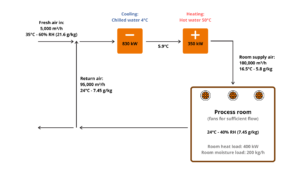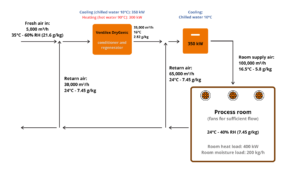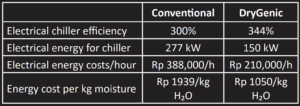Ventilex DryGenic® technology for room conditioning in Indonesia
An example of our mastered technology
This showcase gives an example of a typical food & beverage application in Indonesia, where temperature and humidity conditions in a production room/facility have to be controlled. In this example, the room has the following data:
- Room dimensions: 60m x 30m x 6m (LxWxH)
- Room volume: 10,800 m³
- Personnel in room: 20
- Doors: two large gates & five access doors, total door area 45m²
- Room conditions: 24°C, humidity 40%
The facility is located in Indonesia, with the following typical design ambient conditions: 35°C and a humidity of 60%. The moisture load and heat load of the process room dependent on several parameters, such as the building construction and insulation, internal heat and moisture sources, and door use behavior. Therefore it is difficult to determine the exact heat and moisture load of a room. In this case, we estimated the following design values, based on typical values:
• Moisture load process room: 200 kg/h
• Heat load process room: 400 kW
The conventional system
In the conventional system, moisture is removed from the supply air by cooling the air to a temperature below its dew point. The cooled air subsequently must be re-heated in order to obtain the desired supply air temperature. In the diagram below, an overview of a conventional system for this case is given. It can be observed that the room supply air is 100,000 m³/h, of which 5,000 m³/h is fresh outside air, and the remainder is return air from the room.

The Ventilex DryGenic® system
A Ventilex DryGenic® system for the same situation is shown in the diagram below. The supply air conditions are similar compared to the conventional system (again 100,000 m³/h). Though the dry air flow from the DryGenic® dehumidifier unit is much lower (35,000 m³/h).

Energy comparison
The table below shows an overview of the energy consumption of both systems:

Concluding: the required cooling power of a Ventilex DryGenic® system is significantly lower compared to the conventional system. Additionally, the conventional system requires a lower coolant medium temperature, which increases cooling cost. (estimate for CoP is 3.44 for cooling to 10°C and 3.00 for 4°C).
Cost savings
In this showcase, it is assumed that heating can be provided using waste heat with no extra costs. Cooling will be provided using an electric chiller. The table below gives a summary regarding the energy costs:

Based on this information, we can conclude that electric energy savings of approximately 45% or 127kW can be achieved when using a Ventilex DryGenic® system instead of a conventional system. This means a total cost saving of Rp 178,000 per hour (based on an electric energy price of Rp 1,400 /kWh).